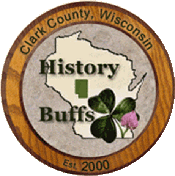In The
Beginning...
From "Curtiss
Centennial 1882-1982"
The Curtiss area, in Clark County originally contained one of the largest
bodies of pine timber to be found in the state. The Black River, which traverses
the county, has occupied a prominent position in the production of pine, while
its resources were abundant in oak, basswood, hickory, butternut and elm.
1830 A.D. TIMBER! North of a line from Green Bay to La Crosse, there
stretched a pine forest unequalled in the world.
The Indians and voyagers had little lasting effect on the land--furs being a
quickly renewable source. This was dramatically changed by the logging operators
whose byword was "Cut out and get out!"
An early explorer, Sieur Radisson, was very impressed with Wisconsin. lie
wrote;
"I can assure you, I liked noe
country as that wherein we wintered; for whatever a man could desire was to be
had in greate plenty; viz, staggs, fishes in abundance, and all sorts of meat,
corne enough .... these kingdoms are so delicious and under so temperat a
climate, plentifull of all things, the earth bringing forth it's fruit twice a
yeare, the people live long and lusty and wise in their way."
From a modest start in 1840, the logging industry built to an apex in the
1880's and 1890's. By 1900, the flow of pine had slowed to a trickle and all but
stopped by 1910. Within the lifetime of a man, the most magnificent stand of
white pine on earth had been reduced to a few scrubby groves.
On the logger's heels, came settlers ..... determined to wrest a living from
the cut-over, burnt-over slashings left by the lumberjacks. Those trying to farm
the barren gravel ridges of Northern Wisconsin had little success. However,
settlers further south fared much better. Here, the hardy pioneers found the
level, fertile ground capable of producing bumper crops. They grew corn, wheat,
oats, potatoes and hay to feed the dairy cattle which were to make Wisconsin
famous.
In the 1870's and 1880's, the railroads, spurred by huge government land
grants, extended their track5 throughout the state. This made all of Wisconsin
readily accessible and provided an impetus to settlement. These early settlers
purchased their land mainly from railroads and the government - little being
available for homesteading. A difficult task was disposing of the huge pine
stumps -- mute memorials to the once-magnificent pinery.
These early settlers, many of them
immigrants, were self-sufficient. They had to contend with harsh winters, poor
roads, few bridges, lack of medical and educational facilities, and the
unending, over- powering isolation. "in this untamed wilderness, those qualities
of the pioneer--hospitality, courage, and fortitude made living more endurable
and enjoyable. Friend or stranger alike could always find a genuine welcome in
the home of the pioneer of this wilderness even if it required personal
suffering and denial of already slim resources to do so. Day after day, the
strong arms of the pioneer swung the ax and the crash of failing trees loudly
proclaimed the dawn of civilization for these fertile regions. Wild birds, deer
and bear were the only living companions of many a pioneer. The days were lonely
and some people began to feel forsaken, but even in this isolated wilderness,
God was with them." ... ... from Curtiss' 75th Anniversary
Booklet
The village of Curtiss was platted November 17, 1882, having been surveyed by
Edwin Parks. The first steps towards incorporation were taken in 1914. A census
was taken by B.B. Green, September 10 and the survey made by S.F. Hewett in
October. The application was made October 14, 1914 and was signed by B.B. Green,
Charles Block, Henry Machiett, Frank Kraut, Albert Laabs, and Herman Boehm. The
petition was granted November 25, 1914, and the charter election was held at the
old schoolhouse in Curtiss.
The judges and inspectors were F.W. Laabs, Glen Reibsamen, and B.B. Green.
Votes were cast to decide if Curtiss should incorporate. Thirty-six votes were
cast; the ayes numbering 33 and the nays numbering 3, for the petition to the
circuit court signed by Herman Boehm, Henry Machiett, Frank Kraut, Albert Laabs,
Charles Block, and B.B. Green. This was after examination of all papers in the
case. Judge James O'Neill declared incorporation null and void February 1, 1917.
On February 5, 1918, a new petition was signed by B.B. Green, T.S. Peterman,
Henry Machiett, Wm. Fahrenbach, John Sturner, Herman Boehm, Charles Block, F.W.
Laabs, and Glen Reibsamen.
The petition was granted March 30, 1917. The election of the judges were B.B.
Green, Glen Reibsamen, and F.W. Laabs. April 24, 41 votes were cast. The
proposition was decided favorably, 32 for and 9 against incorporation.
